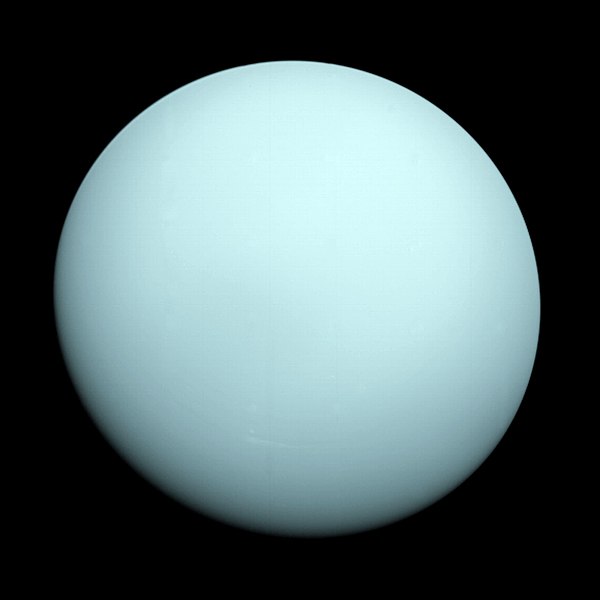
London, Apr 24 (IBNS): Hydrogen sulphide, the gas that gives rotten eggs their charm, appears to permeate the upper atmosphere of the planet Uranus – as has been long debated, but never definitively proven.
Based on sensitive spectroscopic observations with the Gemini North telescope, planetary scientists, including Dr Leigh Fletcher from the University of Leicester, have uncovered the noxious gas swirling high above the giant planet’s cloud tops. This result resolves a stubborn, long-standing mystery of one of our neighbours in space.
Even after decades of observations, and a visit by the Voyager 2 spacecraft, Uranus has held on to one critical secret - the composition of its clouds. Now, one of the key components of the planet’s clouds has been found.
Patrick Irwin from the University of Oxford, UK and collaborators spectroscopically dissected the infrared light from Uranus captured by the 8-meter Gemini North telescope on Hawaii’s Maunakea.
They found hydrogen sulphide, the odiferous gas that most people avoid, in Uranus’s cloud tops. The long-sought evidence is published in the April 23rd issue of the journal Nature Astronomy.
Scientists have long debated the composition of Uranus’s clouds and whether hydrogen sulphide or ammonia dominate the cloud deck, but have lacked definitive evidence either way.
“Now, thanks to improved hydrogen sulphide absorption-line data and the wonderful Gemini spectra, we have the fingerprint which caught the culprit,” says Irwin.
The spectroscopic absorption lines (where the gas absorbs some of the infrared light from reflected sunlight) are especially weak and challenging to detect according to Irwin.
The detection of hydrogen sulphide high in Uranus’s cloud deck (and presumably Neptune’s) contrasts sharply with those of the inner gas giant planets, Jupiter and Saturn, where no hydrogen sulphide is seen above the clouds, but instead ammonia is observed.
The bulk of Jupiter and Saturn’s upper clouds are comprised of ammonia ice, but it seems this is not the case for Uranus. These differences in atmospheric composition shed light on questions about the planets’ formation and history.
Dr Leigh Fletcher, a member of the research team from the University of Leicester’s Department of Physics and Astronomy, adds that the differences between the cloud decks on the gas giants (Jupiter and Saturn), and the ice giants (Uranus and Neptune), were likely imprinted way back during the birth of these worlds.
“During our Solar System’s formation the balance between nitrogen and sulphur (and hence ammonia and Uranus’s newly-detected hydrogen sulfide) was determined by the temperature and location of planet’s formation,” explains Leigh.
According to Dr Fletcher, when a cloud deck forms by condensation, it locks away the cloud-forming gas in a deep internal reservoir, hidden away beneath the levels that we can usually see with our telescopes.
“Only a tiny amount remains above the clouds as a saturated vapour,” said Leigh. “And this is why it is so challenging to capture the signatures of ammonia and hydrogen sulphide above cloud decks of Uranus. The superior capabilities of Gemini finally gave us that lucky break.”
The Gemini data, obtained with the Near-Infrared Integral Field Spectrometer (NIFS), sampled reflected sunlight from a region immediately above the main visible cloud layer in Uranus’s atmosphere.
“While the lines we were trying to detect were just barely there, we were able to detect them unambiguously thanks to the sensitivity of NIFS on Gemini, combined with the exquisite conditions on Maunakea,” adds Irwin. “Although we knew these lines would be at the edge of detection, I decided to have a crack at looking for them in the Gemini data we had acquired.”
Glenn Orton, of NASA’s Jet Propulsion Laboratory and another member of the research team notes: “We’ve strongly suspected that hydrogen sulphide gas was influencing the millimetre spectrum of Uranus for some time, but we were unable to attribute the absorption needed to it uniquely. Now, that part of the puzzle is falling into place as well.”
While the results set a lower limit to the amount of hydrogen sulphide around Uranus, it is interesting to speculate what the effects would be on humans even at these concentrations.
“If an unfortunate human were ever to descend through Uranus’s clouds, they would be met with very unpleasant and odiferous conditions.
But the foul stench wouldn’t be the worst of it according to Irwin
“Suffocation and exposure in the negative 200 degrees Celsius atmosphere made of mostly hydrogen, helium, and methane would take its toll long before the smell,” concludes Irwin.
The new findings indicate that besides being one of the most hostile places for life in the Solar System, Uranus is also downright unpleasant. The study also confirms that this far-flung world is fertile ground for probing the early history of our Solar System and perhaps understanding the physical conditions on other large, icy worlds orbiting the stars beyond our Sun.
Image: Wikimedia Commons
Support Our Journalism
We cannot do without you.. your contribution supports unbiased journalism
IBNS is not driven by any ism- not wokeism, not racism, not skewed secularism, not hyper right-wing or left liberal ideals, nor by any hardline religious beliefs or hyper nationalism. We want to serve you good old objective news, as they are. We do not judge or preach. We let people decide for themselves. We only try to present factual and well-sourced news.







